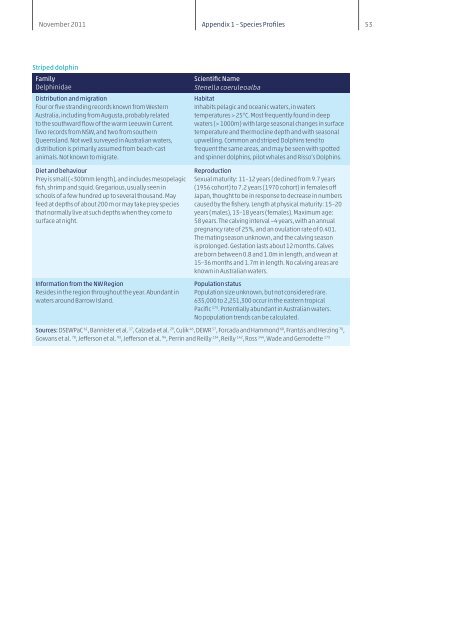Australia's last great whale haven.pdf - Ningaloo Atlas
Australia's last great whale haven.pdf - Ningaloo Atlas
Australia's last great whale haven.pdf - Ningaloo Atlas
- TAGS
- whale
- ningaloo
- atlas
- www.ifaw.org
Create successful ePaper yourself
Turn your PDF publications into a flip-book with our unique Google optimized e-Paper software.
November 2011 Appendix 1 – Species Profiles<br />
53<br />
Striped dolphin<br />
Family<br />
Delphinidae<br />
Distribution and migration<br />
Four or five stranding records known from Western<br />
Australia, including from Augusta, probably related<br />
to the southward flow of the warm Leeuwin Current.<br />
Two records from NSW, and two from southern<br />
Queensland. Not well surveyed in Australian waters,<br />
distribution is primarily assumed from beach-cast<br />
animals. Not known to migrate.<br />
Diet and behaviour<br />
Prey is small ( 25°C. Most frequently found in deep<br />
waters (> 1000m) with large seasonal changes in surface<br />
temperature and thermocline depth and with seasonal<br />
upwelling. Common and striped Dolphins tend to<br />
frequent the same areas, and may be seen with spotted<br />
and spinner dolphins, pilot <strong>whale</strong>s and Risso’s Dolphins.<br />
Reproduction<br />
Sexual maturity: 11–12 years (declined from 9.7 years<br />
(1956 cohort) to 7.2 years (1970 cohort) in females off<br />
Japan, thought to be in response to decrease in numbers<br />
caused by the fishery. Length at physical maturity: 15–20<br />
years (males), 13–18 years (females). Maximum age:<br />
58 years. The calving interval ~4 years, with an annual<br />
pregnancy rate of 25%, and an ovulation rate of 0.401.<br />
The mating season unknown, and the calving season<br />
is prolonged. Gestation <strong>last</strong>s about 12 months. Calves<br />
are born between 0.8 and 1.0m in length, and wean at<br />
15–36 months and 1.7m in length. No calving areas are<br />
known in Australian waters.<br />
Population status<br />
Population size unknown, but not considered rare.<br />
635,000 to 2,251,300 occur in the eastern tropical<br />
Pacific 173 . Potentially abundant in Australian waters.<br />
No population trends can be calculated.<br />
Sources: DSEWPaC 61 , Bannister et al. 17 , Calzada et al. 29 , Culik 46 , DEWR 57 , Forcada and Hammond 68 , Frantzis and Herzing 70 ,<br />
Gowans et al. 78 , Jefferson et al. 93 , Jefferson et al. 94 , Perrin and Reilly 134 , Reilly 142 , Ross 144 , Wade and Gerrodette 173

















